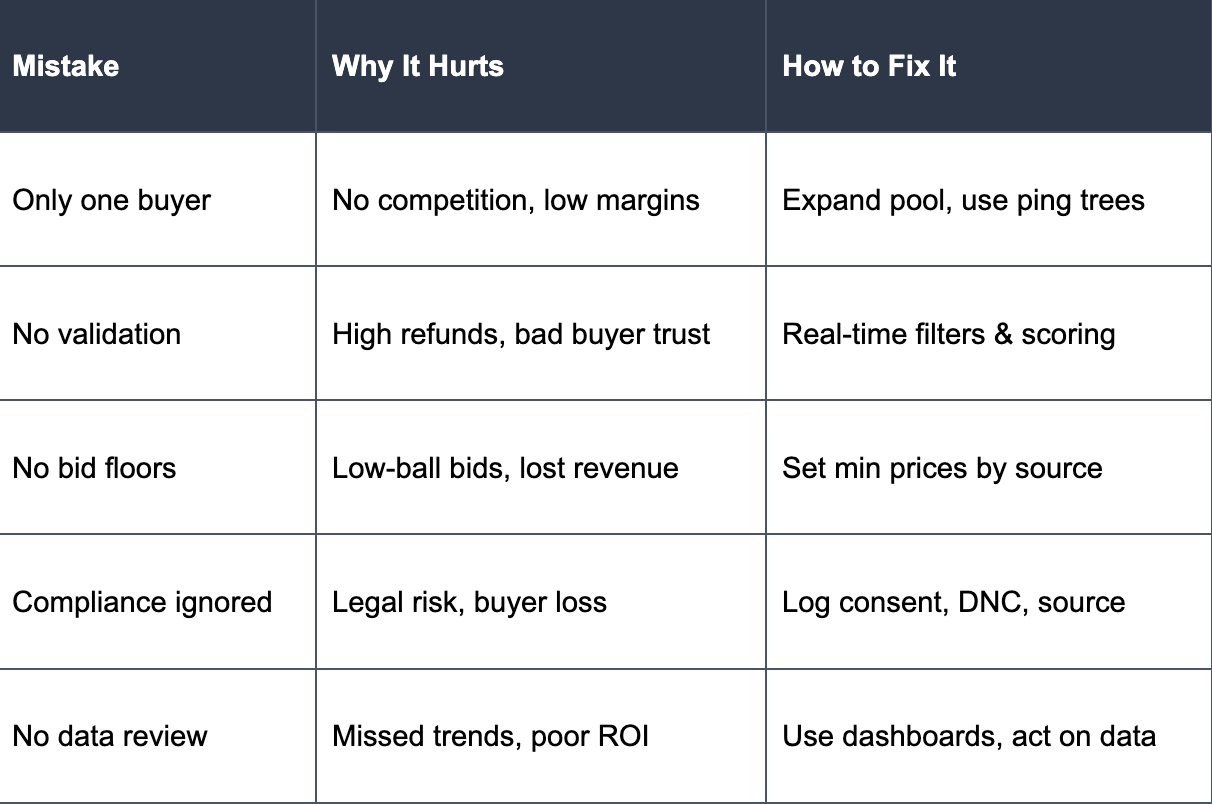Ping post rocks when it works right. Leads go where they should, buyers fight for them, and money comes in with each offer.
But if it doesn't work? It's not a system fail – someone probably messed up the basics.
Here are five common mistakes that ruin ping post – and how to fix them to keep your profits up and your buyers happy.
❌ Mistake #1: Only One Buyer
This is a big issue – it ruins the whole point of ping post.
If you send all leads to just one buyer (even through ping), you miss out on real-time competition. You've just made things more difficult for no reason.
Why it matters: With only one buyer:
- No price war
- Risk of failed delivery or limited leads
- You rely on them, which hurts your ability to negotiate
Fix it:
✅ Get more buyers – even 3–5 can create good bidding.
✅ Use buyer rotation, ping trees, and backups to avoid relying on one source.
✅ If one buyer is always winning, try different prices or areas to make more chances.
Platforms, like Standard Information, make it simple to add buyers with easy setups and instant routing rules – you don't even need a tech team.
❌ Mistake #2: Not Checking Leads Before Pinging
Buyers don't want junk – and sending bad leads is a quick way to get kicked off their list. If you just grab leads and send them without checking, stop.
Why it matters: Bad leads cause:
- Lots of refunds
- Buyers to distrust you
- Lower bids (or no bids)
Fix it:
✅ Check in real-time – phone, email, location, agreement
✅ Use pre-ping filters – so buyers don't see leads that don't match what they want
✅ Rate leads based on behavior or source
With Standard Information, you can check leads instantly and filter them based on what buyers want, time, rating, etc.
❌ Mistake #3: Using One Price for All (or No Minimum Offers)
Ping post is about finding the right price – letting the market show you what a lead is worth. But if you don't have a pricing plan, you're losing money.
Why it matters:
- Some buyers will offer too little
- Room for unfair pricing – or scams
- Buyers learn to pay less for your leads
Fix it:
✅ Set minimum bids – lowest you'll take per lead, by source
✅ Watch bid prices over time and adjust
✅ Don't just send to the highest bidder – think about quality and refund history
Standard Information lets you use custom minimum bids, different pricing levels, and weighted routing – this will help you balance profit and how well everything performs.
❌ Mistake #4: Ignoring the Rules (Until It's Too Late)
Lead sellers often think compliance isn't their problem – especially with ping-post. But if you grab the lead, you're responsible. Ignore it, and everything falls apart.
Why it matters:
- Lawsuits are real (and costly)
- Breaking rules can lead to fines
- Buyers will drop you if compliance is shaky
Fix it:
✅ Get clear agreement with time and IP
✅ Run all leads through do not call lists
✅ Add your legal text to all forms
✅ Record where each lead came from
Use tools like Standard Information to enforce compliance in every lead – from start to finish – without relying on fragile fixes.
❌ Mistake #5: Not Looking at Your Data (Or Doing Anything About It)
You can't fix what you don't track. If you don't watch buyer performance, bid behavior, refunds and conversion rates, you're guessing.
Why it matters:
- You might keep sending leads to a buyer who refunds most of them
- You won't notice bad sources until too late
- You miss chances to grow with your best buyers
Fix it:
✅ Watch bid rate, price, and sales
✅ Track refund reasons
✅ Rate lead sources and improve routing based on how it went before
Standard Information gives you dashboards to see everything – so you can adjust every day, not every month.
🎯 Quick Tip: How to Fix It All Without Starting Over
Let's be honest: fixing ping-post often means simplifying things.
Instead of doing complicated setups, changing buyer lists by hand, or trying to fix problems later, get a platform that makes everything easier from the start. Aim for:
✅ Built-in validation and filters
✅ Easy routing and ping tree setup
✅ Minimum bids, prioritization, and backup plans
✅ Real-time reports and fraud protection
✅ Scheduled ping-post (if you're in industries like solar or legal)
If that sounds tough, try a Standard Information demo – it's built for growth without headaches.
🔄 Recap: 5 Ping Post Problems & How to Solve Them

Final Thoughts
Ping post is more than tech – it's a plan. It is best when you follow the steps and avoid the issues.
If you see low bids, refunds, or buyers leaving, these mistakes might be the reason.
Fix them, and get the right platform, and you'll see what ping post can do: faster sales, better routing, and a stronger business.